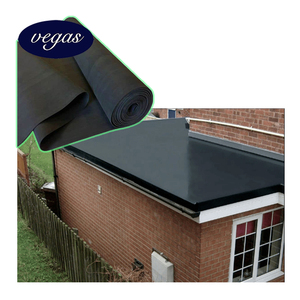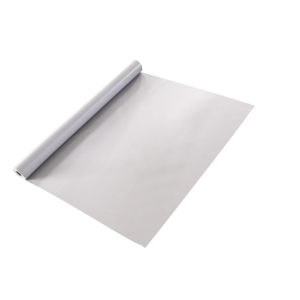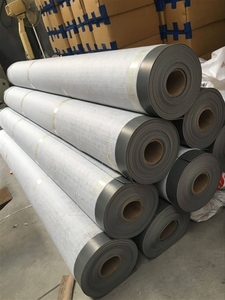(1699 products available)





































































































































































































































A PVC membrane for flat roofs is a material used for roofing applications. It is made of polyvinyl chloride (PVC) plastic and is installed as a single-ply membrane. This type of roofing is commonly used in commercial and industrial buildings but has residential applications. Here are the different types:
Non-Reinforced PVC Membranes:
These membranes are made without any additional materials to make them thicker or stronger. They're just pure PVC. Non-reinforced PVC membranes are the cheapest option for roofs. They're mainly used on roofs that people can walk on, like parking garages or flat roofs over stores. Non-reinforced PVC membranes are also used for repairs. Because they're not as thick, it's easy to patch up holes or tears in other PVC roofs.
Reinforced PVC Membranes:
These membranes are made with extra materials added to make them stronger. Usually, they have a fabric layer inside that helps hold the membrane together. This fabric layer can be polyester or nylon. Reinforced PVC membranes are best for roofs that need to last a long time. Because they're stronger, they don't get damaged easily from the sun, wind, or people walking on them. They also come in different thicknesses, like 45 or 60 mils. A mil is one-thousandth of an inch. The thicker the membrane, the stronger it is. They are used on commercial buildings like stores, offices, and factories.
Adhered PVC Membranes:
These membranes are put on the roof using glue. The glue makes the PVC stick to the roof materials better. Adhered PVC membranes are great for roofs that are sloped. Since the PVC is glued down, it won't blow away in the wind or move with water on sloped roofs. They also work well on roofs over fancy buildings. The glued membrane looks nicer since there are no seams or overlaps. Adhered PVC membranes also help cut noise. In buildings, people can hear sounds from the roof, like wind and rain. The glue helps block those sounds so it's quieter inside.
Ballasted PVC Membranes:
These membranes are held down by heavy rocks instead of glue. Big stones called ballast are placed on top to keep the PVC from moving. Ballasted PVC membranes are quick and easy to install. The rocks are just dropped in place, so no glue is used. Since installation takes less time, ballasted PVC membranes are cheaper than other types. They also work well on roofs that aren't sloped. The rocks may slide or move on sloped roofs, but they stay put on flat roofs. Ballasted PVC membranes are mainly used on warehouses and factories with flat roofs.
Lightweight:
Due to their low weight, PVC membranes are simple to carry and install. They can be put on roofs without worrying about harming the structure since they do not add much weight. PVC membranes are more affordable than other roofing materials. They use less labor and material, decreasing costs.
Durability:
Durability and lifespan are important characteristics of PVC flat roof membranes. These membranes are made to resist environmental elements, such as sunshine, high winds, heavy rain, and extreme temperatures. They are very resistant to tears, holes, and other forms of physical damage. This robustness guarantees that the roof stays intact and does its job well for many years.
Low Maintenance:
PVC roofing membranes are a popular option for flat roofs because they are easy to care for. Regular inspections and simple cleaning are often all that is needed to keep the roof in good shape. This low maintenance requirement saves building owners time and money over the roof's lifespan.
Weather Resistance:
A key advantage of PVC membranes is their ability to withstand weather elements. PVC membranes are robust and long-lasting, providing long-term protection for flat-roof structures. First, PVC membranes are great at repelling water. They form a solid, continuous barrier when applied to the roof. This barrier keeps water from seeping through and protects against leaks and water damage.
Cost-Effective:
A PVC flat roof membrane's low maintenance requirements and long lifespan make it a cost-effective roofing option. While the upfront cost may be similar to or slightly higher than other membrane materials, the long-term savings in maintenance and replacement are significant.
Easy Installation:
PVC membranes are popular among builders and contractors. Their ease of installation helps keep the overall labor costs reasonable. Some PVC membranes can be welded together using heat, creating strong seams that won't leak. Other types have adhesive-backed seams that peel and stick for quick application.
Weldable Seams:
Heat welding is a technique that joins PVC membrane sheets into a durable, leak-proof surface. The welded seams are as strong as the membrane material itself, providing structural integrity and long-lasting performance. Heat welding requires special tools and training, so a skilled installer must do it. However, the resulting roof is low-maintenance and highly resistant to wind uplift.
Environmentally Friendly:
PVC roofing has many advantages for people and the environment. One important aspect is that PVC material can be recycled. At the end of its usable life, a PVC membrane can be processed and turned into new roofing membranes or other PVC products. This recycling capability helps reduce waste going to landfills.
The demand for PVC roofing membranes continues to grow among wholesalers and construction companies. This is due to their numerous advantages and applications in different industries and sectors. Some common usage scenarios of PVC roofing membranes are:
Commercial Buildings
Most commercial and industrial buildings use PVC flat roof membranes. These include shopping malls, schools, hospitals, factories, warehouses, and office buildings. The commercial buildings often have high foot traffic. Therefore, they need durable roofing materials that can withstand frequent maintenance without being damaged. PVC membranes are a popular choice for this application because they are cost-effective and require low maintenance. They also have a long lifespan, which reduces the need for replacement, cutting down on long-term costs.
Residential Flat Roofs
PVC roofing membranes are also suitable for residential homes with a modern architectural design and flat roofs. They help improve the home's energy efficiency by reflecting sunlight and reducing heat. PVC membranes are also recyclable, making them an ideal choice for environmentally conscious homeowners.
Garages and Outbuildings
PVC roofing membranes are commonly used in garages, sheds, and other outbuildings. These structures usually have a tight budget for construction and maintenance. Therefore, they benefit from the cost-effectiveness and low maintenance of PVC roofing. Additionally, using PVC membranes in outbuildings can help extend their lifespan and reduce long-term costs.
Green Roof Applications
Some PVC membranes, like reinforced PVC roofing, are specifically designed for green roof applications. Their waterproofing abilities protect the roof from damage caused by plants and growing media. These membranes also have root-resistant properties that prevent plant roots from penetrating and damaging the roof.
Ballasted Roof Systems
Unreinforced PVC membranes can be used in ballasted roof systems. In this setup, the membrane is secured using heavy stones or concrete blocks. The ballast protects the membrane from UV rays and wind uplift, making PVC membranes a suitable choice for this application.
When choosing a PVC membrane for a flat roof, consider the following factors:
Durability
The chosen PVC membrane should be durable and resist damage from UV rays, chemicals, and extreme weather. This helps ensure the roof will last for many years.
Weight
Lightweight membranes are easier to transport and install. However, a heavier membrane may provide better durability depending on the application.
Thickness
A thicker PVC membrane is generally more durable and resistant to punctures and tears. For example, a 60 mil PVC membrane provides more durability than a 50 mil or 45 mil membrane. However, building codes and budget constraints may influence the choice of thickness.
Joint sealing method
Consider how joints will be sealed during installation. Hot air welding forms a permanent, strong bond, but it requires skilled labor. Adhesive seams are easier to apply but may not be as durable long-term.
Climate conditions
The local climate should influence the choice of PVC membrane. If the area experiences high winds, choose a membrane that can resist wind uplift. In very sunny areas, pick a membrane with UV stabilizers.
Installation method
Some PVC membranes can be mechanically fastened, while others are adhered or ballasted. The installation method should suit the building and budget.
Building regulations
Ensure the chosen PVC membrane complies with local building codes and regulations. This helps prevent legal issues and ensures safety.
Aesthetics
Although function is most important, consider aesthetics if the flat roof is visible. Choose a color or finish that suits the building style.
Cost
Higher-quality PVC membranes may have a higher upfront cost but can last longer and need less maintenance. Consider the long-term value, not just the short-term price.
Q1: Is PVC roofing easy to install?
A1: Yes, PVC roofing is relatively easy to install. PVC membranes are lightweight and have simple mechanical fastening systems. However, professional installation is recommended as it involves hot welding techniques for secure seams.
Q2: How can someone increase the lifespan of their PVC roof?
A2: Proper maintenance is key to ensuring PVC roofs last long. This involves regular cleaning to remove debris and prevent ponding water. It's also important to conduct regular inspections and address potential issues promptly.
Q3: Are PVC roofs environmentally friendly?
Q4: PVC roofs have some level of recyclability. Some manufacturers use recycled materials in the production process, contributing to the membranes' recyclability.Q4: Are PVC flat roof membranes durable?
A4: Yes, PVC membranes are very durable. They have a long lifespan, lasting 20-30 years. PVC membranes are also resistant to typical flat roof challenges, such as pooling water, UV rays, and temperature fluctuations. They remain intact and perform well, thanks to their reinforced fabric and chemical composition.
The keyword "pvc membrane for flat roof" maintains a stable web search volume with an average of 10 monthly web searches, showing no significant change over the past year. The data reveals a consistent pattern where web searches peak at 10 during months from March to June and then again from September to November, with a noticeable dip in August where web searches drop to zero.
This trend indicates that there are specific times of the year when interest in "pvc membrane for flat roof" increases. The peaks in web search volume from March to June could be linked to the onset of warmer weather, which is typically favorable for construction and roof maintenance activities. Similarly, the renewed interest from September to November might coincide with preparing for winter, as property owners look to ensure their roofs are in good condition to withstand harsh weather conditions.
The absence of web search volume in December, January, February, and August suggests a seasonal disinterest or possibly a lack of construction activities during these colder months or holiday seasons. This pattern of web search volume fluctuations throughout the year could reflect industry cycles and seasonal construction practices within the real estate sector.